Chapter 10
Pay Up: Side Hustles and Taxes
IN THIS CHAPTER
![]() Surveying income-tax basics for your side hustle
Surveying income-tax basics for your side hustle
![]() Avoiding temptation that can lead to tax trouble
Avoiding temptation that can lead to tax trouble
![]() Following all the tax-filing rules
Following all the tax-filing rules
![]() Sending important tax documents to others
Sending important tax documents to others
![]() Collecting and filing sales taxes
Collecting and filing sales taxes
Even if you’re doing your side hustle on your own rather than with a partner or with the assistance of employees, plenty of other people want to share in your success — specifically, your friends and family.
Guess who else wants to share in your success? The tax people.
And unlike your friends and family, who share in your success by offering you encouragement and celebrating your accomplishments, the tax people want something from you. Actually, they want two things from you:
- Lots of documents and forms
- Money
Like it or not, you’ll need to deal with all sorts of tax-related matters for your side hustle. Some of the tax stuff is pretty easy to understand, while other tax-related requirements and rules can get tricky. So, buckle up!
Income Taxes and Your Side Hustle: The Basics
You won’t find a one-size-fits-all playbook or checklist for your taxes. Your tax-filing requirements will vary depending on:
- The legal organization you set up for your side hustle
- What type of business you’re doing for your side hustle
- Where you live and work
Filing requirements based on your side hustle’s legal organization
If you organized your side hustle as a sole proprietorship or a single-member limited liability company (LLC), I have good news for you: Your U.S. federal tax filings for your business will be just another section of your personal taxes on your Form 1040. You don’t have to file any separate returns, at least at the federal level. You will, however, need to file an additional form — a Schedule C — that is basically an attachment to the rest of your personal tax return (see “Keeping the feds happy,” later in this chapter).
What if you set up your side hustle as an S corporation or a partnership? Or what if you set up an LLC with a partner? Great news … if you enjoy more paperwork. In addition to your personal tax return, you’ll need to file a separate return, not just an additional form attached to your personal tax return. Depending on how you structured your business, you need to file either:
- Form 1065 if your side hustle is organized as a partnership or a multi-member LLC
- Form 1120-S if your side hustle is organized as an S corporation
The more complicated your side hustle’s legal structure is, the more complex your tax filing requirements will be — basically, you have a straight-line relationship up the complexity ladder. But I step you through the highlights in the “Filing Your Side-Hustle Income Taxes” section later in this chapter.
Tax rules and forms depending on your specific side hustle
If your side hustle is service-oriented and you aren’t dealing with any physical inventory, your tax returns won’t be all that complicated, even if you did set yourself up as an S corporation or a partnership. If, however, you’re running an online store where you need to keep track of your cost of goods sold (see Chapter 8) and the value of your inventory, then not only is your overall side hustle record-keeping more complicated, but your taxes may turn into a head-scratcher, too.
Everyone wants a piece of the tax action
If you live in the United States, you’re well aware of the Internal Revenue Service (IRS). If you live outside the United States, then you need to file tax returns with the equivalent of the IRS in your country.
You don’t only have to pay up and file returns with the feds, however. Your state and maybe even your city want their cut of your side-hustle profits, and you’ll need to file the proper returns along with writing the checks or doing the electronic funds transfers to pay the taxes that you’ll owe.
As complicated as the federal side of taxes can be, in many cases the state and local side is even more complicated. Why?
- If you’re doing your side hustle in Arizona, you’ll file different state tax return forms than if you’re side hustling in Pennsylvania or California or any other state.
- Some states just wants a copy of your federal return, but others have their own sets of forms. And to complicate matters even further, many states allow different deductions for expenses than the feds do, meaning that the net income from your side hustle for tax purposes may be different for the IRS than it is for the state where you live.
- Some cities get in on the act also, and you have to file yet another set of tax returns — and shell out even more money — to the city where you live and where you’re side hustling. Or maybe you’re getting hit at the county level rather than the city level. Sometimes those local taxes are only on W-2 wages (basically, the money you make from your day job), but in other cases, they’re full-blown tax returns that apply to side hustles.
Decision time
You have two paths you can take when it comes to your side-hustle taxes and filing your returns:
- Do it yourself.
- Hire an accountant.
Even if you decide that you want to do your own taxes, you don’t have to study up on a ton of tax laws that are always changing or do a whole lot of calculations by hand. All the big tax-filing programs such as Credit Karma Taxes, TaxSlayer, TurboTax, and many others will step you through not only your personal taxes but also basic small-business taxes that would apply to your side hustle, no matter how you set up your business (sole proprietorship, partnership, S corporation), even if your side hustle is just another part-time job with a regular old W-2.
- Avoid the temptation to use your side hustle to “get creative” with your tax returns.
- Be aware that if your side hustle crosses state lines, your tax picture could get murky and complicated.
- Remember that tax laws change frequently and can be tricky.
- Be sure to correct any tax-related mistakes that you make.
Staying Legal and Staying Honest
Maybe you’ve read or heard someone saying something along the lines of “I deduct all kinds of expenses through my home business — it’s great!”
Business deductions for your side hustle
Suppose your side hustle is an online retail site, where you buy clothing items from wholesalers that you then list and sell. While you’re buying clothing items for your business, why not buy some for yourself that you can “hide” among your business purchases? Then you can deduct all that clothing, and basically get your jeans and shirts and shoes at a 30 percent or 35 percent discount because you’ll owe less in federal and state taxes.
Don’t do it!
Maybe you do a little bit of traveling for your side hustle, and you deduct all those travel-related expenses. You know what? Why not deduct the costs of your next family vacation as well? You already have a bunch of legitimate tax deductions for airfare, hotels, meals, and other travel expenses, so who would ever know if you added a few more travel expenses that really shouldn’t be on your side hustle’s tax return?
Don’t do it!
Suppose you send a lot of packages to your customers via FedEx, UPS, and the U.S. Postal Service (USPS). Everything that you spend on packing materials and shipping costs is deductible. Why not also include the cost of shipping about a dozen packages to your out-of-town friends and family members for the holidays?
Don’t do it!
Will the government really come after you for claiming $100 in shipping expenses that you shouldn’t have, or for “only” $2,000 in personal travel that you inaccurately claimed as a legitimate business expense? Maybe not — but do you really want to take the chance?
Taking your side hustle across state lines
Even if you’re determined to be 100 percent honest when it comes to your business taxes, you still need to be aware of several complications that could affect you, depending on what you do for your side hustle.
How would you like to be treated like a professional athlete? Well, maybe you can’t dunk a basketball or hit a 100-mile-per-hour fastball or score a game-winning field goal. But you can pay taxes to a bunch of different states just like the pros!
Before long, many states had versions of California’s law governing out-of-state athletes playing professional games within their borders, and those pro athletes found themselves (or, more accurately, found their accountants) filing tax returns in a bunch of different states each year.
So, what does all this jock tax stuff have to do with side hustles? If your side hustle is, say, doing some consulting work that involves travel to a different state, you could find yourself subject to the same paying-some-other-state tax laws as Michael Jordan or almost every other professional athlete. Even though my personal experience with the non-athlete’s equivalent of the jock tax came from my full-time consulting days rather than from one of my side hustles, I’ve seen and dealt with this complicated tax picture first-hand.
Now for your next side-hustle tax trick …
Your full-time employer sends you a W-2 tax form that shows you how much you earned in salaries, bonuses, and other taxable income. You then use the numbers from that W-2, or give the form to your accountant, as the foundation for the income portions of your personal tax return. If you had more than one job during the year, you’ll have multiple W-2s that you combine onto the “Wages, Salaries, Tips, etc.” line near the top of your tax return.
What about your side-hustle income? Unless your side hustle is something like part-time teaching, where you’ll receive a W-2 because you’re technically an employee of a university or community college, you won’t receive any W-2s for your side-hustle income. Instead, you may receive a Form 1099-MISC and/or a Form 1099-NEC.
Beginning in 2018 and thanks to tax-law changes in the United States called the Tax Cuts and Jobs Act, some nonemployee compensation and other income got even more complicated when it came to tax season. This time, however, the complications were actually good for tax filers, including many side hustlers.
In the past, if you earned $50,000 from your side hustle after deducting all your expenses, you would be taxed on that full $50,000 in addition to your full-time salary, interest, dividends, and all the usual taxable items in any given tax year. Now, thanks to the 2018 tax law, you’re allowed to deduct up to 20 percent of your side-hustle income before you start figuring out your taxes. So, that $50,000 that used to be fully taxable gets magically changed into $40,000 by deducting $10,000 (20 percent) before you do your tax calculations.
- A sole proprietorship
- A partnership
- An S corporation
- A limited liability company (LLC)
Well, guess what? Take a look at Chapter 7 and your options for setting up the legal structure of your side hustle. Let’s see: a sole proprietorship … a partnership … an S corporation … an LLC. Four for four! So, in almost all cases, your side hustle will have passed the first test to take advantage of that wonderful 20 percent deduction.
The TCJA law has a lot of other technicalities that you really don’t need to worry about, because either your tax software or your accountant will take care of walking through the complications and rules for you.
Uh-oh — you goofed!
Your side hustle taxes can get really complicated. Even though you try to be as accurate as possible, sometimes you make a mistake.
So, did you forget to file your side-hustle business taxes on time back in March? And did you also forget to file an extension? Or did you forget to include some of your side-hustle income or accidentally enter the wrong number for an expense? Maybe you made a mistake the other way around: you double-counted some of your side hustle income or forgot to include some legitimate business expenses, and wound up paying more in taxes than you actually should have.
Likewise, if you forgot to file a return by a deadline, get that form in as soon as you can to cut down on the amount you’ll have to pay in interest and penalties — not to mention avoiding potential legal issues for not filing your taxes.
Filing Your Side-Hustle Income Taxes
Nobody really enjoys filing taxes and paying up, but there’s no escaping it, so you might as well get going for your side hustle. You’ll need to file
- Federal taxes
- State taxes
- Maybe even local taxes
Keeping the feds happy
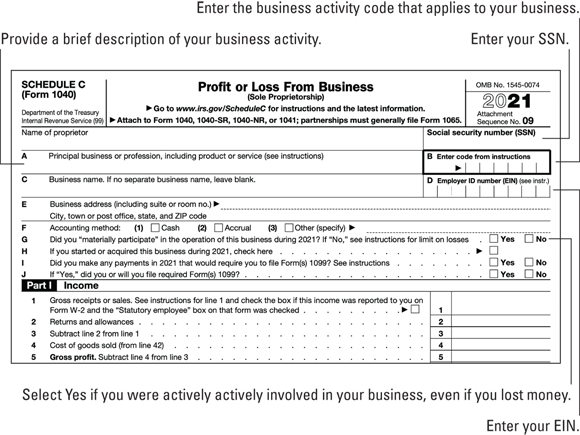
FIGURE 10-1: Use a Schedule C to file your side-hustle taxes for a sole proprietorship or single-member LLC.
If you filed for and obtained an employee identification number (EIN) for your side hustle, you need to show both your personal Social Security number (SSN) and your EIN on your Schedule C (refer to Figure 10-1). The IRS separates your tax return into various forms, schedules, and attachments before it does its processing, so this way it can keep track of not only your side hustle (via your EIN) but which individual is actually running that side-hustle business.
You also need to enter what your side-hustle business is (for example, online retail or book editing) onto your Schedule C, along with a standard business activity code that identifies your business (refer to Figure 10-1). The IRS can periodically change those business activity codes, so make sure that you always check each year to make sure you’re using the correct code. You can find them at www.irs.gov/pub/irs-pdf/i1040sc.pdf.
What if you set your side hustle up as an S corporation? You have to file a separate tax return, right? Figure 10-2 shows Form 1120-S, which you need to file if you organized your side hustle as an S corporation. You can download the form at www.irs.gov/pub/irs-pdf/f1120s.pdf.
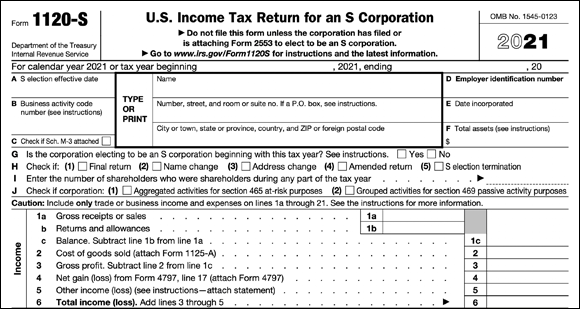
FIGURE 10-2: Use Form 1120-S to file your side-hustle taxes for an S corporation.
Suppose you sold $10,000 worth of products last year, and you spent $2,000 to buy those products. You’ll do the simple math on your 1120-S to come up with $8,000 of total income. Easy, right?
Notice, though, that on Form 1120-S, you enter your side hustle’s EIN, but not your personal SSN. You also don’t directly pay taxes when you file a Form 1120-S. Instead, that information needs to get attached to your personal return. But how does the IRS know that the Form 1120-S is for you, when your SSN isn’t anywhere on your business tax return?
Figure 10-3 shows a Schedule K-1 that your side-hustle business will issue to you as an individual. Yeah, that sounds a bit formal for a side hustle, but that’s how the IRS keeps all the money stuff straight. Notice that the Schedule K-1 has both your side-hustle EIN and the rest of your side-hustle basic information (company name, business address, and so on), as well as your personal SSN and your personal information. You can download Schedule K-1 at www.irs.gov/pub/irs-pdf/f1065sk1.pdf.
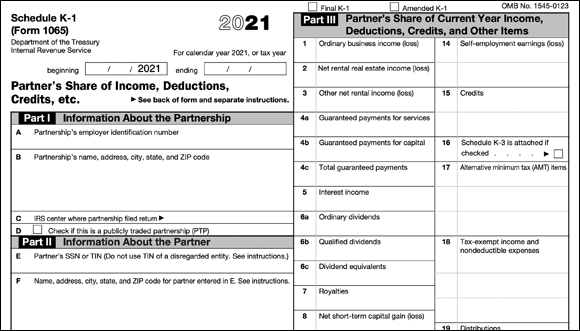
FIGURE 10-3: Use a Schedule K-1 to link your side hustle business tax return with your personal tax return.
Suppose you file your business taxes on March 15. When you file your personal taxes a month later, you’ll attach Schedule K-1 to the rest of your personal tax return and enter your net business income onto a Schedule E on your personal tax return (see Figure 10-4) to make sure that you do your tax calculations correctly. You can download Schedule E at www.irs.gov/pub/irs-pdf/f1040se.pdf.
Your Schedule E will contain your personal SSN (refer to Figure 10-4), which the IRS uses to link all this tax data to you personally. You also indicate the official business name of your side hustle and that you set your business up as an S corporation, along with your side hustle’s EIN (refer to Figure 10-4). Presto! The IRS now has all your side-hustle S corporation information and your personal information, all linked together, including your business income (refer to Figure 10-4), which you pull from your Schedule K-1 (refer to Figure 10-3).
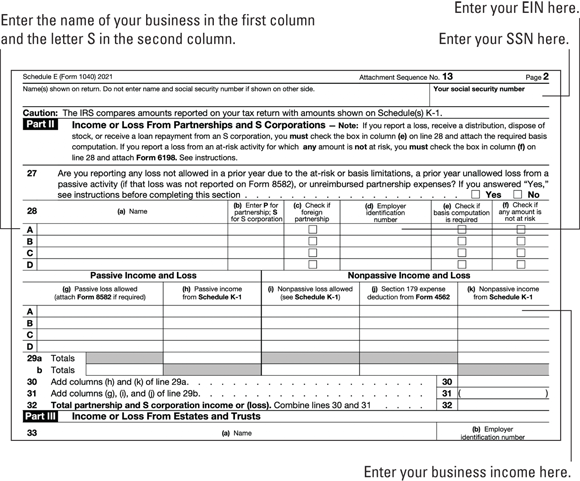
FIGURE 10-4: Transfer your side-hustle income information from your Schedule K-1 onto a Schedule E for your tax calculations.
If you and one or more partners legally organized your business as a partnership, you’ll file Form 1065 (shown in Figure 10-5). You can download Form 1065 at www.irs.gov/pub/irs-pdf/f1065.pdf.

FIGURE 10-5: Use Form 1065 to file your taxes if you organized as a partnership.
Suppose you and one other person went in together on a side hustle. You would enter the number 2 on the line that says, “Number of Schedules K-1. Attach one for each person who was a partner at any time during the tax year” (refer to Figure 10-5). Just like your K-1 from an S corporation, you would receive a K-1 from your partnership — and so would your one partner in this case, because you indicated on the form that two K-1s were attached, meaning that your side hustle is made up of two partners.
Your state wants their cut, too
Every state has its own laws and peculiarities. If you do your own taxes, your tax software will step you through your state filings after you’re done with your federal returns. If you hand all your tax-filing stuff over to an accountant, they’ll take care of the state side for you as well — including any cross-state filing requirements that may apply (see “Taking your side hustle across state lines,” earlier in this chapter).
Keeping your tax money local
Calculating and Filing Estimated Income Taxes
If you only make a little bit of money from your side hustle, you may not have to worry about filing quarterly estimated tax returns and making quarterly payments. If, however, your side hustle is bringing in a fair bit of money, then you definitely need to at least take a look at whether you need to do estimated tax filings.
If you do need to file estimated returns and make payments, pay attention to the filing deadlines, which are:
- April 15 for your first quarterly payment
- June 15 (only two months after your previous payment, not three months) for your second quarterly payment
- September 15 for your third quarterly payment
- January 15 of the following year (four months later) for your fourth and final quarterly payment
The standard “15th day of the month” could also shift a few days later if the 15th day of a month in which a payment is due falls on a weekend or holiday (see the sidebar “I’m late, I’m late for a very important tax date”).
Tracking and Reporting Payments You Made to Others
If you make certain types and amounts of payments to other businesses for your side hustle, you need to do even more tax filing. Yay! (Or would that be “Groan”?)
Just as you receive 1099 forms for some of your side-hustle income (unless your side hustle is an S corporation; see “Keeping the feds happy,” earlier in this chapter), you’ll need to send 1099 forms to other businesses to which you pay money.
And if you enjoy the additional tax paperwork from sending 1099 forms, you’ll really appreciate that you have to file yet another form: the 1096. Will this tax paperwork ever end?
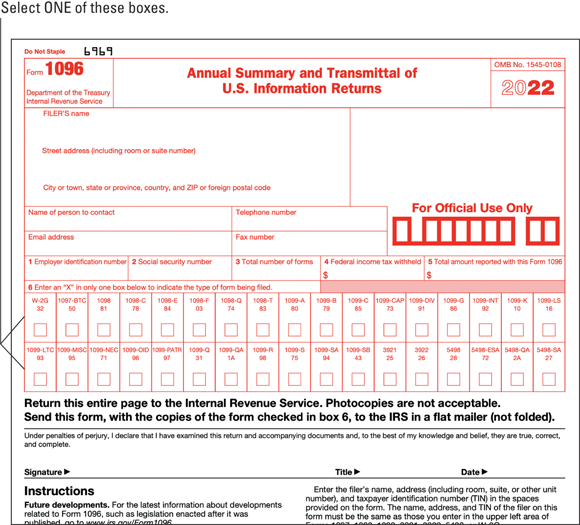
FIGURE 10-6: File Form 1096 to help the IRS keep track of who your side hustle paid money to.
Think of Form 1096 as sort of an envelope for your 1099 forms. Most likely, you’ll be sending 1099-NECs for nonemployee compensation. On Figure 10-6, the IRS tells you that you need to check one and only one box to indicate which of the many different types of 1099s you’re sending, as well as some other IRS forms that most likely won’t apply to your side hustle.
Figure 10-7 shows Form 1099-NEC, which you fill out to send to some other business that you paid for, say, website development help. Notice that you need to include your taxpayer identification number (TIN), which is your EIN (if you have one) or your SSN, as well as the TIN of the business that you paid. You can download Form 1099-NEC at www.irs.gov/pub/irs-pdf/f1099nec.pdf.
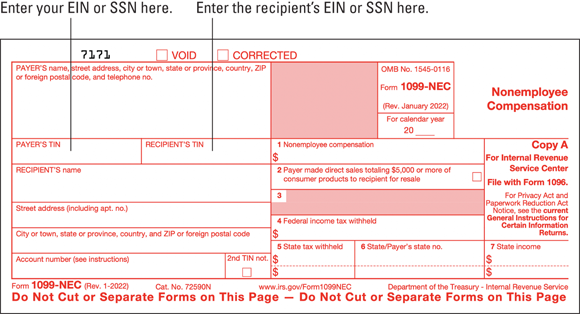
FIGURE 10-7: File Form 1099-NEC to tell the IRS who you paid money to for your side hustle.
Likewise, when you get set up to do business with people who will be paying you, you’ll need to fill out a Form W-9. You don’t file the W-9 with the IRS; instead, you send the completed W-9 to the other company so that when they issue you a 1099-NEC at the end of the year, they have your tax information ready to go. You can download Form W-9 at www.irs.gov/pub/irs-pdf/fw9.pdf.
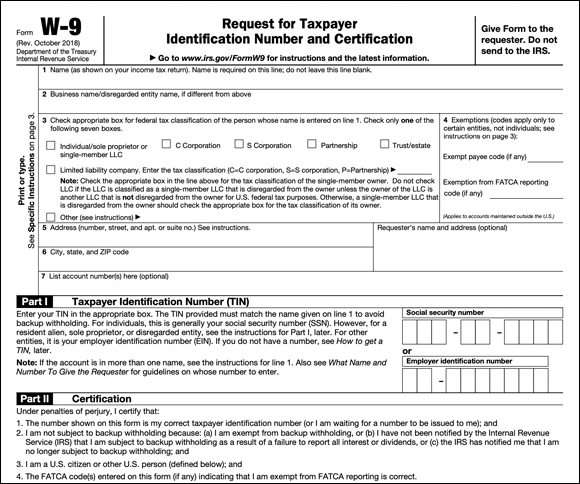
FIGURE 10-8: Form W-9 is where you their share tax identification numbers and details with people who hire you (or get that information from people you hire).
Sales Taxes and Your Side Hustle
Income taxes aren’t the only type of taxes you need to worry about for your side hustle. You may need to collect and submit sales taxes as well.
- You may have to collect and submit sales taxes not only to your state, but also your county and city.
- You may have to collect and submit sales taxes to other states beyond where you live.
- You may have to collect and submit sales taxes for products that you sell in person, but not online. Or you may have to submit sales taxes for every product that you sell.
- If someone who lives in another state buys something from you in person, you may or may not have to collect sales tax, depending on your state’s laws.
- You may have to only worry about sales taxes for products that you sell, or you may also have to deal with sales taxes for services if you live somewhere that charges sales taxes on, say, consulting or doing software development.
You also need to file for a sales tax license or permit. You may need to file for a sales tax license or permit from your city or county. Sometimes a sales tax license is referred to as a transaction privilege tax (TPT) — basically, you’re being taxed for the “privilege” of being able to conduct business transactions.
If you were to examine a hundred side hustles from all around the country, you could have a hundred different circumstances when it comes to side hustle sales taxes, with no two businesses having identical situations.

 Don’t worry, your Form 1040 for your personal tax return won’t feel left out if your side hustle financials show up on either a Form 1065 or a Form 1120-S. Technically, you don’t pay taxes on either S corporation or partnership income — at least not directly. If you used either of those legal structures for your side hustle, your business income (or loss) will pass through to your Form 1040, where you’ll mash all those details together with income from your day job, your personal deductions, and the rest of your personal tax stuff. You use an IRS form called a K-1 to carry your side hustle corporate or partnership finances over to your personal return. (You’ll have slightly different versions of a K-1 depending on whether your side hustle is an S corporation, a partnership, or a multi-member LLC.)
Don’t worry, your Form 1040 for your personal tax return won’t feel left out if your side hustle financials show up on either a Form 1065 or a Form 1120-S. Technically, you don’t pay taxes on either S corporation or partnership income — at least not directly. If you used either of those legal structures for your side hustle, your business income (or loss) will pass through to your Form 1040, where you’ll mash all those details together with income from your day job, your personal deductions, and the rest of your personal tax stuff. You use an IRS form called a K-1 to carry your side hustle corporate or partnership finances over to your personal return. (You’ll have slightly different versions of a K-1 depending on whether your side hustle is an S corporation, a partnership, or a multi-member LLC.) Remember this simple equation: The more physical items you have that play any sort of a role in your side hustle, the more complicated your taxes will be. If you’re buying goods to resell, or if you need to purchase shelving and containers to hold products, then your taxes will be more complicated than if you’re recording and uploading videos, or doing software work, or doing ridesharing for Uber or Lyft.
Remember this simple equation: The more physical items you have that play any sort of a role in your side hustle, the more complicated your taxes will be. If you’re buying goods to resell, or if you need to purchase shelving and containers to hold products, then your taxes will be more complicated than if you’re recording and uploading videos, or doing software work, or doing ridesharing for Uber or Lyft. Even if you made the command decision to hire an accountant to file the tax returns related to your side hustle, you still need to pay attention to some key points and beware of a few big-time traps that could really trip up you and your side hustle. Specifically:
Even if you made the command decision to hire an accountant to file the tax returns related to your side hustle, you still need to pay attention to some key points and beware of a few big-time traps that could really trip up you and your side hustle. Specifically:  If that person’s statement really meant “I legally deduct all kinds of allowable expenses through my home business,” then no problem. If, however, the statement actually meant “I sneak in all kinds of personal expenses and deduct them through my home business” then that person may be in for all sorts of tax and legal problems. And if you follow in their footsteps and start playing shady tax games with your side hustle, you could wind up in a lot of trouble.
If that person’s statement really meant “I legally deduct all kinds of allowable expenses through my home business,” then no problem. If, however, the statement actually meant “I sneak in all kinds of personal expenses and deduct them through my home business” then that person may be in for all sorts of tax and legal problems. And if you follow in their footsteps and start playing shady tax games with your side hustle, you could wind up in a lot of trouble.